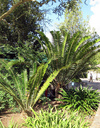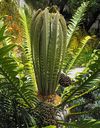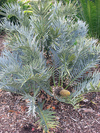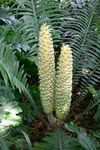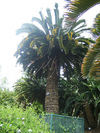Genus Encephalartos
Encephalartos is a genus of cycad native to Africa.Species in the genus Encephalartos of plants
Bread tree cycad - This cycad grows up to seven metres tall and may be branched or unbranched. The leaves are straight or curved backwards and up to three metres in length. The leaflets are rigid and fairly broad with one or both margins toothed. There are no prickles at the base of the leaf which distinguishes it from E. natalensis. There are usually two to five greenish-yellow cones up to fifty centimetres long, the female scales covered with protuberances. The seeds are scarlet and up to four centimetres long.
Zululand cycad - The species was first described in 1851 when material was collected from Mozambique. After looking at material found in Natal, South Africa, it was redescribed as E. kosiensis Hutchinson. After looking more carefully at the material, the original name was kept, and the redescribed name was no longer used.
Eastern cape blue cycad - Mature plants have big stems of between 0.5-1m in length and 20-30cm in diameter
Ituri forest cycad - This cycad grows to 6 metres tall with a trunk diameter of 50 cm. It has glossy dark green leaves. The leaflets are curved and tapering, with a spine at the top and several teeth along the margin.
Karoo cycad - This cycad grows up to two metres tall with a trunk diameter of up to forty five centimetres and may be branched or unbranched. The leaves are up to one hundred and fifty centimetres long, blue or silver and strongly keeled. The leaflets are lanceolate, do not overlap each other and have smooth margins. The male cones are green or brown and up to thirty five centimetres long. The female cones are a similar colour and up to fifty centimetres long. The seeds are red and up to four and a half centimetres long.
Thunberg's cycad - Encephalartos longifolius is a low-growing palm-like cycad in the family Zamiaceae. It is endemic to South Africa and is commonly known as the breadpalm or broodboom.
Encephalartos transvenosus - The tree grows up to twelve metres tall with a thick trunk deeply scored in a netted pattern. This is crowned by nearly straight, shiny, spiny pinnate leaves up to two and a half metres long. The leaflets are broad, the middle ones up to about three centimetres in width, slightly curved and with small marginal teeth. Two to four large cones are borne in the heart of the leaves. The female cone may reach eighty centimetres long, weigh thirty four kilograms and have brilliant orange-red seeds.
Encephalartos villosus - A largely underground trunk results in very little of the plant being visible, so that it is described as a dwarf species. The preferred habitat of this species is frost-free coastal bush. It hybridises readily with Encephalartos altensteinii in the Eastern Cape and with Encephalartos lebomboensis in the Pongola area.
Wood's cycad - It is palm tree like, and can reach a height of 6 metres . The trunk is about 30–50 centimetres in diameter, thickest at the bottom, and topped by a crown of 50–150 leaves. The leaves are glossy and dark green, 150–250 centimetres in length, and keeled with 70–150 leaflets, the leaflets falcate , 13–15 centimetres long and 20–30 millimetres broad.







